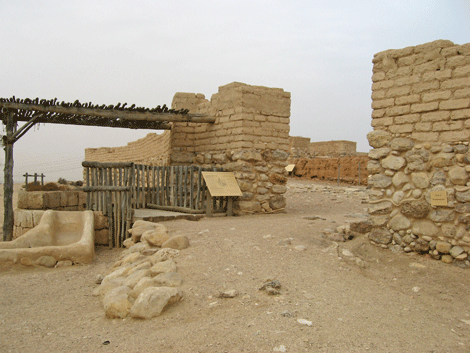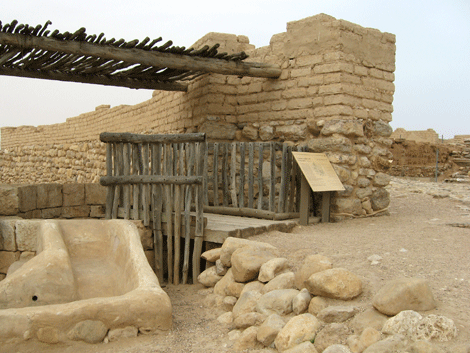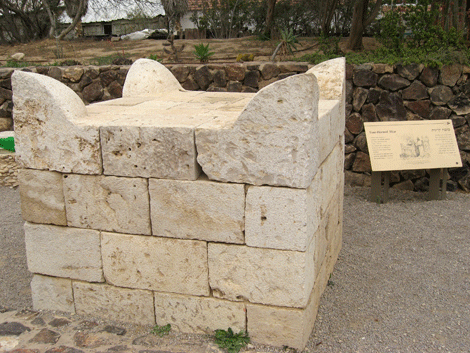|
 |
|
 |
|
In the ancient Near East, where women were
confined to the homestead, the only place a
woman could meet a man she didn’t know was
by the city well. The well was the virtual
equivalent of a singles bar! Here are some
examples: Rebecca meeting Abraham’s servant,
Rachel meeting Jacob, Zipporah and her
sisters meeting Moses and Jesus meeting the
Samaritan woman. All these meetings took
place at the nearby watering hole. |
|
|
The best place one can visualize a meeting
at the city well is at Tel Beersheba, an
hour and three quarters drive south of
Jerusalem. On reaching the site, we walk up
a dusty path to reach the well, located
right outside the city gate. This unlikely
location puzzled archeologists for two
reasons. One, it’s uphill, almost 200 feet
above the water table in the valley below. And two, they wondered why the ancients
would leave their water source unprotected. |
|
|
|
 |
|
Photo:
Gila Yudkin |
|
City well at the left of
entrance to ancient Beersheba |
|
Some archeologists I studied with even
suggested that this was a “virtual” well,
constructed specifically for pilgrims
familiar with the Genesis “well stories” of
Beersheba. For both Abraham and Isaac, the
well at Beersheba was a source of conflict
between them and their neighbors, the
Philistines.
The Bible tells us that the city itself was
named to commemorate a peaceful settlement
of the dispute. “Beer” means well and
“sheba” means both oath and seven,
symbolizing the seven ewe lambs set aside as
an oath of friendship. “Abraham said,
‘Accept these seven ewe lambs from my hand
as a witness that I dug this well.’
Therefore that place was called Beersheba,
for both of them swore an oath.” (Genesis
21:30-31) |
|
|
Ancient Beersheba residents knew that the
first question tourists would ask upon
arrival would be, “Hey, where’s the famous
well?” So they deliberately dug a well
located outside the city gate so ancient
pilgrims could stop to admire this famous
site, quench their thirst and take some
photos (only kidding!) without disrupting
city life within. |
|
|
|
 |
|
Photo:
Gila Yudkin |
|
The well (behind the
trough on left) is 210 ft deep! |
|
|
Imagine then the archeologists’ surprise
when the well was excavated at the end of
the 20th century. At the depth of 210 feet,
they actually found water! Well, that put
the “virtual well” theory to rest. |
|
|
I love sitting with a group on shaded
benches opposite the well and retelling the
story of the choosing of a wife for
40-year-old Isaac. I once heard a favorite
tour leader make a calculation that based
upon the fact that a camel can drink up to
50 gallons of water at a time and Abraham’s
servant had ten camels, Rebecca, carrying a
5-gallon jar, could have had to go to the
well to draw water 100 times. He then asked
the group, “What kind of wife would she be
to Isaac?” Participants suggested
“hard-working, compassionate, helpful and
strong.” But once when I asked that question
myself, to my dismay, the pastor blurted
out, “Dumb!” |
|
|
|
After reading our well stories in Genesis 21
and 26, we make our way through the city
gate with its reconstructed mud-brick walls
to climb up onto the observation tower. From
here we get an unparalleled grasp of the
geography of the land with its biblical
ramifications. To the south we have the
wilderness of the Negev leading to the Sinai
where the Children of Israel sojourned for
forty years. |
|
|
To the east we can see almost as far as Arad,
from where the Israelites were repulsed in
their first efforts to directly penetrate
into the Land of Canaan. (Numbers 21) To the
west we see the coastal plain and Philistine
country. Gaza, the Philistine capital, is a
mere 28 miles away. The continuing dispute
over water rights of the Philistines first
with Abraham, and then Isaac, echoes eerily
in the water disputes of the present day. |
|
|
|
Donning a “hard-hat,” we leave the “tel” or
mound of Beersheba via the original steps,
perhaps chiseled out in the time of King
Hezekiah, to explore the recently excavated
8th century B.C. water system. Don’t miss it
– it’s awesome! |
|
|
| If you haven’t visited Tel Beersheba in
recent years, consider stopping by this
ancient watering hole on your next
pilgrimage. It’s well worth it. |
|
|
|
 |
|
Photo: Gila Yudkin |
|
Reconstructed altar once
standing at Beersheba |
|
|
Copyright 2007, 2012 Gila Yudkin. Permission
needed for any reuse. |
|
|
|
Gila Yudkin,
who calls herself a Connecticut-born Yankee
living in King David’s court, has been
sharing biblical insights on site in the
Holy Land for over 30 years. She loves
showing new discoveries at the old dusty
somewhat-forgotten and under-visited sites.
Her tours are a mix of archeology,
geography, Bible and fun. |
|
|

